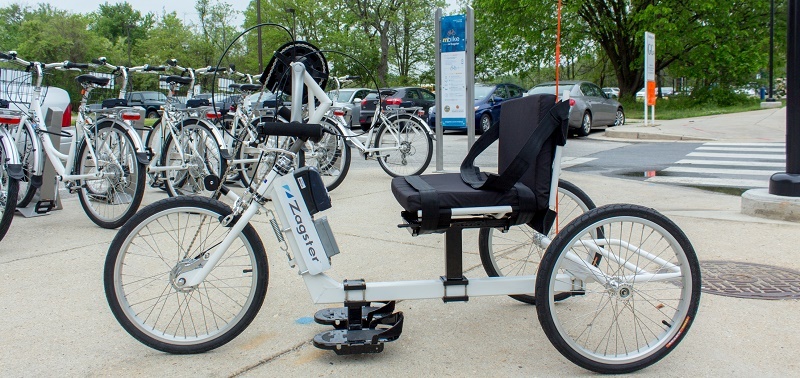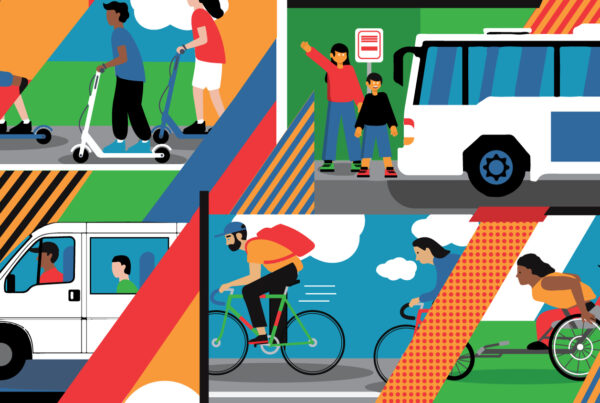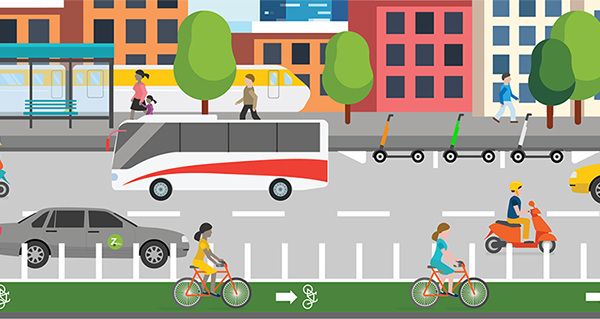The City of Portland’s new bikeshare system features 1,000 bright orange bikes, 100 stations and many first-of-their kind features, such as the ability to reserve a bike and variable pricing for bike parking.
Soon, it will also be one of the first big-city bikeshare systems to offer adaptive bikes for people with disabilities.
Despite the industry’s growing focus on opening up bikesharing access to low-income neighborhoods and other underserved areas, less has been said about the need to reach residents whose disabilities prevent them from renting and riding a standard bike.
However, that is beginning to change as a handful of new bikeshare systems have launched in the past year – including in College Park, Maryland and Westminster, Colorado – that include options for disabled riders. When Portland’s adaptive bicycling pilot debuts in 2017, it will be one of the largest cities to offer adaptive bikeshare bikes, perhaps setting a precedent for other big cities to follow.
If bikeshare is a form of public transit, after all, it seems to only make sense that cities do what they can to accommodate riders of all types and abilities. But some have also questioned whether the challenges of integrating adaptive bikes into a system – including cost, availability and safety – will prevent bikesharing from ever truly offering parity to disabled riders.
What’s an Adaptive Bike?
Cycling offers a great, low-impact way to improve cardiovascular fitness and socialize with friends and family. Adaptive bikes, which are modified to suit the needs of an individual rider, help to make one of the healthiest and most environmentally friendly modes of transport accessible to riders of all abilities.
Common variations of adaptive bikes include:
- Standard trikes feature three wheels, which makes it easier for the rider to balance. Trikes can also be fitted with footplates to assist with pedaling, and can be upright or recumbent.
- Side-by-side tandems are built to allow two people to bike together, and offer a great option for pairs of riders with different cycling abilities or limitations. Tandems usually have a pair of seats set side by side, along with two sets of pedals and two independent transmissions.
- Hand-cycles, which are often used by people with limited or no lower-body movement, feature handles instead of pedals that are used to steer as well as propel the bike forward. Hand-cycles typically have three or four wheels.
- Heavy-duty bikes retain traditional bike design but are more stable and can accommodate larger riders.
The Growth of Adaptive Bikesharing
Carmel, Indiana launched its bikesharing system in April 2015 with operator Zagster. In addition to 16 standard Breezer bikes, the system also featured six three-wheeled trikes, making it one of the first in the U.S. to include adaptive cycles. (While bikesharing provider Bcycle started experimenting with integrating trikes into its systems as early as 2013, it appears they are no longer available.)
More recently, Zagster has helped several other smaller cities and universities launch systems with adaptive bikes. College Park, Maryland’s mBike program, which debuted in May, features 120 standard bikes and five adaptive bikes, including tandem bikes, trikes and hand-cycles. Westminster, CO launched its system in June with 32 traditional cruisers and eight adaptive bikes—three hand-cycles and five trikes—at 5 stations, making one of every five bikes within the system adaptive. Ohio State University and Corvallis, Oregon have also launched adaptive systems.
“Just as we believe all communities can benefit from biking, we believe everyone within those communities can benefit from bikesharing, too,” said Zagster Communications Manager Jon Terbush. “As physical equity gains traction in the bikesharing industry, more providers will follow our lead.”
One of Zagster’s advantages is that the company’s model relies on u-locks mounted on the bikes themselves, said Terbush, as opposed to the docking technology used by larger systems like New York’s Citi Bike. As a result, the company does not have to make any significant alterations to accommodate adaptive cycles, which can easily be secured to Zagster’s standard, tech-less bikeshare stations.
“When you suddenly have access to something that everyone else gets to use, it’s an amazing feeling,” said Carol Tyson, a DC-based transportation equity consultant and advocate who has tried out the adaptive cycles in Zagster’s systems.
“I have friends who are avid [bikeshare] users, and I could never use it, and that hurt,” she said. “I know that DC is using public money to fund bikesharing for the city’s residents, but I’m a resident and it’s not serving me. We need to make sure that everyone has access to these new and innovative modes of transportation…that should be first and foremost in people’s minds.”
Growing Awareness
According to Terbush, one of the issues hindering increased adoption of adaptive bikeshare bikes has been sheer unfamiliarity with the concept. Few people are aware accessible bikes exist, let alone that they can be used in bikesharing, so it’s often not even a consideration.
The good news is that’s starting to change. The City of Portland did not originally anticipate including adaptive cycles in its system, for instance, but altered its plans after disability advocate and city council candidate Chloe Eudaly and others called on the city’s bureau of transportation to add adaptive options.
“The public conversation about the issue triggered us to look harder at it,” Biketown project manager Steve Hoyt-McBeth said in an interview with The Oregonian.
As a result of community input, Portland DOT employees spent the month of June researching adaptive bikes. Their efforts included attending Portland’s 12th annual Adaptive Bicycle Clinic, where they rode trikes and talked with local riders and advocates.
The event featured participants such as Michael Trimble, who is a daily Portland bike rider despite being born without arms in an orphanage in Chernobyl, Russia.
“I was told it was impossible to do what I wanted to do, that I was a legal liability,” he said in an interview with BikePortland.org. After ten years “I just woke up one day and said, ‘Goddamnit, I want to bike!’”
Trimble’s custom-built bike was on display at the event along with a wide variety of hand-cycles, trikes, recumbents, and tandems (be sure to check out BikePortland’s piece for some great photos from the clinic).
Is Bikeshare the Right Tool?
Despite the buzz around Portland’s pilot, many have acknowledged it is not a perfect solution. The city will manage the adaptive cycles separately from the rest of the system, providing one to three-hour rentals through several local bike shops. Additionally, the pilot will initially include only six adaptive bikes.
However, in designing its pilot, the city has had to confront a number of issues. According to PBOT’s website, the majority of individuals with disabilities interviewed by the agency expressed the desire for staff assistance to help them move between their mobility device and the adaptive bicycles. They also indicated they would need a way to store their wheelchairs while they used the service and, due to safety issues, preferred not to ride on trails or paths where cars and other motorized vehicles were present.
Other systems have also encountered issues. For instance, in her recent post for Mobility Lab about the importance of adaptive bikesharing, Carol Tyson noted that it took her 45 minutes to find one of the shared hand-cycles on the Ohio State University campus.
In general, it seems as though more questions need to be answered before adaptive bikesharing can truly scale. For instance, how many adaptive bikes does a system need in order to provide sufficient access for disabled riders? How will the bikes integrate with the rest of the system? And, how might introducing different types of bikes affect the economics and efficiency of a bikeshare program?
“To me, it seems like we’re trying to get to third base before we get to first,” said Randy Neufeld, bike expert and director of the SRAM cycling fund. “There is a lot of important work to do to help people with disabilities to get bikes, but trying to do it first with bikeshare may be too big of a lift.”
Rather than answering the question of how to get adaptive cycles into bikesharing systems, Neufeld suggests cities should focus on figuring out how can to get more adaptive bikes into people’s hands in general.
“We should start by asking people what their travel needs are, rather than asking them how bikesharing can meet their needs,” said Neufeld.
If more fact finding is called for, Portland’s approach of conducting research, attending events and interacting with adaptive cycle users may provide a good example for other cities to follow as they explore and experiment with their own solutions.
“Ultimately the selection of the stations and bikes is up to our community partners,” said Zagster’s Terbush. “They have a much better sense of what their needs are. We’re the experts in bikesharing, and they are the experts in their communities.”
“There is a huge opportunity for people who love bikesharing and people with disabilities to work together to improve safety and accessibility of systems,” said Tyson. She also noted that, in addition to the bikes themselves, cities need to ensure that bikeshare docking stations meet ADA requirements and do not impede access to bus stops, sidewalks or other public infrastructure.
According to Neufeld, as bikesharing evolves, there may be a need for totally new models that serve a wider variety of people – such as families with children and riders who may be too big or small to fit on a standard bike – even if that means expanding our idea of what bikesharing is.
“Maybe we’ll move toward a solution that is more like round-trip carsharing, where you use bikes for longer periods of time,” said Neufeld.
If you have thoughts on advances you would like to see happen or issues you’d like to explore related to adaptive bikesharing, please share them with us at [email protected] and we’ll keep the conversation going. Also, make sure to follow us on Twitter and ‘like’ us on Facebook to get the latest updates on shared-use mobility trends.
Don’t forget to join us at the 2016 National Shared Mobility Summit to talk about these and other developments in bikesharing, including flexible systems, electric bikesharing and more. Click here to register today.
Image credit: Zagster



